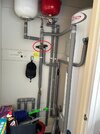Hi,
We have an unvented hot water cylinder for some years.
Recently we notice an issue with water dripping via the tundish suggesting a fault. This only happens when the hot water scheduler comes on to heat the water. Within the first 10-15mins we notice water dripping via the tundish, and stops once the motorised zone closes off i.e. boiler stops. The water via the tundish is cold initially, and after a period it probably feels semi warm. The discharged water is never hot from observations so far.
You can hear a slight hissing sound coming from the combination water valve thats connected in from the cold mains i.e. the combined pressure reducing valve (3.5bar), check valve and expansion valve (6bar). Based on the sound and temperature of the discharge, suspect it likely coming from this combo valve rather than the temperature/pressure release valve (10bar) on the cylinder.
We had a service on the unvented cylinder recently to check. Hoping that the issue is more simpler and either requiring a pressure charge in the expansion vessel or just requiring the pressure release valves to be opened and re-seated etc.
The expansion vessel is suppose to be 3.5bar but at the time of check was about 2.8-3bar. So was topped up. All the pressure release valves were tested, water discharges fine and re-seats properly.
However, despite after the service we're still getting water dripping via the tundish as before when hot water heats up.
So the next steps proposed is to get the entire combination valve replaced (like-for-like).
I'm able to get the exact same part (santon brand) relatively cheap at £60. So planning on doing this.
The quoted labour for replacing this is £90+VAT (not sure how long that takes and what's involved i.e. does that require draining the cylinder etc?)
Firstly, can I confirm based on the fault observed that the proposed action of replacing this combination valve is reasonable?
And can someone advise if the quoted labour cost is also reasonable for this?
Thanks!
We have an unvented hot water cylinder for some years.
Recently we notice an issue with water dripping via the tundish suggesting a fault. This only happens when the hot water scheduler comes on to heat the water. Within the first 10-15mins we notice water dripping via the tundish, and stops once the motorised zone closes off i.e. boiler stops. The water via the tundish is cold initially, and after a period it probably feels semi warm. The discharged water is never hot from observations so far.
You can hear a slight hissing sound coming from the combination water valve thats connected in from the cold mains i.e. the combined pressure reducing valve (3.5bar), check valve and expansion valve (6bar). Based on the sound and temperature of the discharge, suspect it likely coming from this combo valve rather than the temperature/pressure release valve (10bar) on the cylinder.
We had a service on the unvented cylinder recently to check. Hoping that the issue is more simpler and either requiring a pressure charge in the expansion vessel or just requiring the pressure release valves to be opened and re-seated etc.
The expansion vessel is suppose to be 3.5bar but at the time of check was about 2.8-3bar. So was topped up. All the pressure release valves were tested, water discharges fine and re-seats properly.
However, despite after the service we're still getting water dripping via the tundish as before when hot water heats up.
So the next steps proposed is to get the entire combination valve replaced (like-for-like).
I'm able to get the exact same part (santon brand) relatively cheap at £60. So planning on doing this.
The quoted labour for replacing this is £90+VAT (not sure how long that takes and what's involved i.e. does that require draining the cylinder etc?)
Firstly, can I confirm based on the fault observed that the proposed action of replacing this combination valve is reasonable?
And can someone advise if the quoted labour cost is also reasonable for this?
Thanks!



